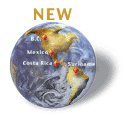|
||||||||||||||||||
|
|
|
|
||||
< Previous Next >PHASE 1 DRILLING PROGRAM NOW UNDERWAY ON BENZDORP PROPERTY, SURINAMEVancouver, British Columbia, Canada Canarc Resource Corp. (CCM : TSX and CRCUF : OTC-BB)
The JQA and Roche Kreek prospect areas host broad zones of porphyry-style gold mineralization in diorite stocks that intrude the andesite volcanics of the Benzdorp greenstone belt. JQA in particular is a large target of stockwork vein and fracture mineralization measuring at least 1,000m long by up to 500m wide, open in several directions. Fine gold occurs within quartz-limonite veinlets associated with potassic alteration and elevated copper and molybdenum values in the deeper samples. Canarc’s previous exploration work in the JQA prospect area is suggestive of a large, multi-million oz, porphyry-style gold target grading in the 0.5 gpt to 1.5 gpt range. Drilling will initially test a 900m x 450m portion of the JQA prospect with four fences of short angled holes (75m to125m deep) to evaluate the saprolite mineralization already outlined by dozens of 10m deep auger holes and several large trenches. Since saprolite mineralization represents the near-surface, oxidized, soft, clay altered portion of gold deposits in a tropical environment, it does not normally need to be drilled, blasted and crushed for mining and can be processed using simple gravity and flotation methods to recover the gold. Therefore, it has lower costs and higher profits than bedrock mineralization. At Benzdorp, the saprolite can be as thick as 80m beneath the laterite-capped hilltops or as little as 20 m thick below the gravel-filled valleys, averaging about 50m thick. An excellent example of saprolite gold mining in South America is the Brasilia mine in Brasil owned by RTZ and Kinross. In 2002, the mine produced 223,000 oz gold from 18.4 million tonnes saprolite ore grading 0.48 gpt gold with only a 79% recovery. Their cash operating costs were a low US$167 per oz, mine output exceeded 50,000 tons per day, and a 50% expansion of the mill-rate is scheduled in 2003. The JQW, JQS and Pointu Kreek prospect areas host shear-vein gold mineralization along northeast-trending structures crosscutting the basaltic andesite volcanic rocks. This style of mineralization is more typical of higher-grade gold mines in ancient greenstone belts like the Ashanti mine in Ghana. Gold occurs with sulphide/oxide minerals in quartz-calcite veins and replacements within the shear zones. The Pointu Kreek structure where partially exposed in trench samples grades from 44 gpt over 2 m to 2.45 gpt over 17m and appears to form the western boundary to the JQA prospect over a distance of at least 1 km. The Phase 1 program will initially test only one cross section line in each of the high-grade targets with short scissor holes to ensure that any parallel, mineralized zones are also intersected. The drill program is anticipated to take about 75 days and initial assays are expected in August. On Behalf Of The Board Of Directors For more information, please contact Gregg Wilson at tel: (604) 685-9700, fax: (604) 685-9744, email [email protected] or visit our website, www.canarc.net. The TSX Exchange has neither approved nor disapproved the contents of this news release. Suite 800 - 850 West Hastings Street, Vancouver, B.C., Canada, V6C 1E1 Tel: (604) 685-9700 Fax: (604) 685-9744 |

|
|||
disclaimer |
||||

